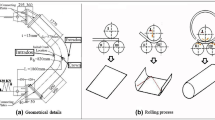Abstract
The pipes are subjected to different load conditions such as internal stress, compression, tension, bending and/or any combination thereof. These various types of load conditions induce new cracks and/or cause propagation of the existing cracks. In this study, a TP316L stainless steel pipe subjected to four-point bend testing was examined to predict the propagation of fatigue cracks in a part-through cracked pipe using the CASCA and FRANC2D programs. Two different methods based on “rigidity” and “stress intensity factor” have been proposed for converting a three-dimensional pipe into a two-dimensional beam for modeling.








Similar content being viewed by others
References
Liu M, Luo S, and Shen Y, Eng Failure Anal97 (2019) 493.
Guan R, Lu Y, Wang K, and Su Z, Struct Health Monit18 (2019) 180.
Bodai M, Fukuta Y, Asada S, and Hayashi K, in ASME 2019 Pressure Vessels & Piping Conference, American Society of Mechanical Engineers Digital Collection (2019).
Dadfarnia M, Sofronis P, Brouwer J, and Sosa S, Int J Hydrogen Energy44 (2019) 10808.
Carpinteri A, Ronchei C, and Vantadori S, Fatigue Fract Eng Mater Struct36 (2013) 1164.
Andrews A, and Folger P, Nuclear Power Plant Design and Seismic Safety Considerations, Congressional Research Service (2012).
Rahman S, Nuclear Eng Des195 (2000) 239.
Kumar P, Sahu V K, Ray P K, and Verma B B, Mech Mater Sci Eng (2016). https://doi.org/10.13140/RG.2.2.16973.03043
Kumar P, Patel H, Ray P K, and Verma B B, Mech Mater Sci Eng (2016). https://doi.org/10.13140/RG.2.2.23243.18724
Gross D, and Seeling T, Fracture Mechanics with an Introduction to Micromechanics, Springer, Berlin (2006).
Paris P C, and Erdogan F, Trans ASME J Basic Eng85 (1963) 528.
Pilkey W D, Peterson’s Stress Concentration Factors, 2nd Edition, Wiley, Hoboken (1997).
Barsom J M, and Rolfe S T, Fracture and Fatigue Control in Structures: Application of Fracture Mechanics, 3rd Edition, ASTM, West Conshohocken (1999).
Ono T, and Tanaka K, Effective of Scribing wheel dimensions on the cutting of AMLCD glass substrates, Technical Information Paper, Corning Incorporated, 306, November 2004.
Stress Intensity Factors Handbook, Vol. 1, Committee on Fracture Mechanics, The Society of Material Science, Japan, Pergamon Press (1986).
Author information
Authors and Affiliations
Corresponding author
Additional information
Publisher's Note
Springer Nature remains neutral with regard to jurisdictional claims in published maps and institutional affiliations.
Rights and permissions
About this article
Cite this article
Kumar, P., Makhatha, M.E., Sengupta, S. et al. Prediction of the Propagation of Fatigue Cracks in Part-Through Cracked Pipes with CASCA and FRANC2D. Trans Indian Inst Met 73, 1417–1420 (2020). https://doi.org/10.1007/s12666-020-01886-z
Received:
Accepted:
Published:
Issue Date:
DOI: https://doi.org/10.1007/s12666-020-01886-z




